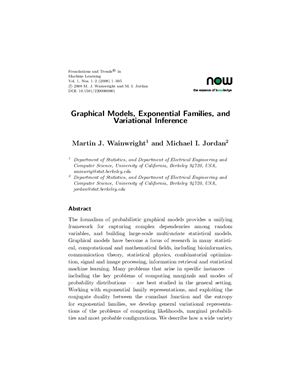Из серии Foundations and Trends in Machine Leaing издательства
NOWPress, 2008, -305 pp.
The formalism of probabilistic graphical models provides a unifying framework for capturing complex dependencies among random variables, and building large-scale multivariate statistical models. Graphical models have become a focus of research in many statistical, computational and mathematical fields, including bioinformatics, communication theory, statistical physics, combinatorial optimization, signal and image processing, information retrieval and statistical machine leaing. Many problems that arise in specific instances — including the key problems of computing marginals and modes of probability distributions — are best studied in the general setting. Working with exponential family representations, and exploiting the conjugate duality between the cumulant function and the entropy for exponential families, we develop general variational representations of the problems of computing likelihoods, marginal probabilities and most probable configurations. We describe how a wide variety of algorithms — among them sum-product, cluster variational methods, expectation-propagation, mean field methods, max-product and linear programming relaxation, as well as conic programming relaxations — can all be understood in terms of exact or approximate forms of these variational representations. The variational approach provides a complementary alteative to Markov chain Monte Carlo as a general source of approximation methods for inference in large-scale statistical models.
Introduction
Background
Graphical Models as Exponential Families
Sum-Product, Bethe–Kikuchi, and Expectation-Propagation
Mean Field Methods
Variational Methods in Parameter Estimation
Convex Relaxations and Upper Bounds
Integer Programming, Max-product, and Linear Programming Relaxations
Moment Matrices, Semidefinite Constraints, and Conic Programming Relaxation
Discussion
A Background Material
B Proofs and Auxiliary Results: Exponential Families and Duality
C Variational Principles for Multivariate Gaussians
D Clustering and Augmented Hypergraphs
E Miscellaneous Results
The formalism of probabilistic graphical models provides a unifying framework for capturing complex dependencies among random variables, and building large-scale multivariate statistical models. Graphical models have become a focus of research in many statistical, computational and mathematical fields, including bioinformatics, communication theory, statistical physics, combinatorial optimization, signal and image processing, information retrieval and statistical machine leaing. Many problems that arise in specific instances — including the key problems of computing marginals and modes of probability distributions — are best studied in the general setting. Working with exponential family representations, and exploiting the conjugate duality between the cumulant function and the entropy for exponential families, we develop general variational representations of the problems of computing likelihoods, marginal probabilities and most probable configurations. We describe how a wide variety of algorithms — among them sum-product, cluster variational methods, expectation-propagation, mean field methods, max-product and linear programming relaxation, as well as conic programming relaxations — can all be understood in terms of exact or approximate forms of these variational representations. The variational approach provides a complementary alteative to Markov chain Monte Carlo as a general source of approximation methods for inference in large-scale statistical models.
Introduction
Background
Graphical Models as Exponential Families
Sum-Product, Bethe–Kikuchi, and Expectation-Propagation
Mean Field Methods
Variational Methods in Parameter Estimation
Convex Relaxations and Upper Bounds
Integer Programming, Max-product, and Linear Programming Relaxations
Moment Matrices, Semidefinite Constraints, and Conic Programming Relaxation
Discussion
A Background Material
B Proofs and Auxiliary Results: Exponential Families and Duality
C Variational Principles for Multivariate Gaussians
D Clustering and Augmented Hypergraphs
E Miscellaneous Results

